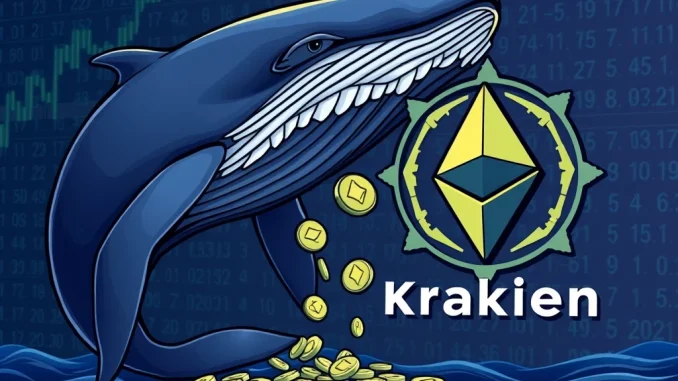
A significant movement on the Ethereum blockchain has captured the attention of market observers. An early participant in the Ethereum (ETH) initial coin offering (ICO), often referred to as an Ethereum whale due to their substantial holdings, recently transferred a considerable amount of ETH to the Kraken crypto exchange. This type of transaction is closely watched by traders and analysts alike, as large movements from long-term holders can sometimes precede significant market activity.
Understanding Ethereum Whale Activity
Who are these ‘whales’ and why do their movements matter? In cryptocurrency markets, a whale is an individual or entity that holds a very large amount of a particular digital asset. These holders acquired their positions early, often at much lower prices than current market value. Because of the sheer size of their holdings, their trading decisions, particularly large deposits to exchanges, have the potential to influence market supply and price dynamics.
In this specific instance, the whale in question participated in the Ethereum ICO, a historic event that funded the development of the Ethereum network. This means they have held their ETH for many years, weathering numerous market cycles. Their decision to move 1,050.5 ETH, valued at approximately $2.74 million at the time of the transfer, is noteworthy because depositing funds onto an exchange is often a precursor to selling, although it can also be for other reasons like staking, trading, or diversification.
The Significance of an ETH Deposit to Kraken
Depositing cryptocurrency onto a major platform like the Kraken exchange makes the assets readily available for trading. Unlike holding ETH in a personal wallet, funds on an exchange are liquid and can be quickly sold into stablecoins or other cryptocurrencies, or withdrawn as fiat currency.
When a large holder, especially an early investor with significant unrealized gains, moves a substantial amount of ETH to an exchange, the market often interprets this as a potential increase in selling pressure. While a $2.74 million deposit is not massive in the context of Ethereum’s total market capitalization, it is a significant amount for a single entity and warrants monitoring, particularly if followed by actual selling activity.
Potential reasons for such an ETH deposit could include:
- Selling: The most common interpretation is that the whale intends to sell some or all of the deposited ETH to realize profits or manage risk.
- Trading: The whale might plan to use the ETH for active trading strategies on the exchange.
- Staking: Some exchanges offer staking services, and the whale might be moving funds to participate in ETH staking rewards (though direct wallet staking is also common).
- Diversification: The whale could be preparing to exchange ETH for other assets available on the exchange.
- Custodial reasons: The whale might prefer using the exchange’s custodial services for a portion of their holdings.
Without direct confirmation from the whale, these remain possibilities informed by typical market behavior.
Decoding On-Chain Data for Insights
The information about this transfer comes from On-chain data, specifically reported by the analytics platform Onchain Lens. On-chain analytics involves examining the publicly available transaction records on a blockchain. This data provides transparency into the flow of assets, allowing analysts to track large movements, identify wallets associated with specific entities (like exchanges, funds, or known large holders), and gain insights into market sentiment and potential future supply changes.
Tools that analyze on-chain data can track funds from their origin (like an ICO participation) to their current location and subsequent movements. This allows for identifying wallets belonging to early investors and monitoring their activity. The ability to see these transactions provides a unique layer of transparency in the crypto market, enabling a more informed understanding of where large amounts of capital are moving.
The Role of an Early Investor
This particular whale is identified as an Early investor from the Ethereum ICO. They initially received 10,095 ETH during the offering. While they deposited 1,050.5 ETH, they still retain a significant holding of 7,261.84 ETH across various wallets, currently valued at approximately $19.1 million. This indicates that the recent deposit represents only a fraction of their total ETH holdings.
Early investors often hold a unique position in the market. Their cost basis is typically very low, giving them significant flexibility regarding selling or holding. Their movements are often seen as indicators of long-term sentiment or strategic portfolio rebalancing rather than short-term trading noise. Monitoring these wallets provides valuable context for understanding potential supply-side shifts in the market.
Conclusion: Monitoring the Market Impact
The deposit of $2.74 million in ETH by an early ICO participant to the Kraken exchange is a data point worth noting for anyone tracking Ethereum. While not a definitive signal of a market crash, it represents a large block of ETH becoming liquid on an exchange. Market participants will be watching to see if this deposit is followed by significant sell orders or if the funds are utilized for other purposes on the platform. On-chain data continues to be an invaluable tool for gaining transparency into the movements of large holders and understanding the potential implications for the market.



